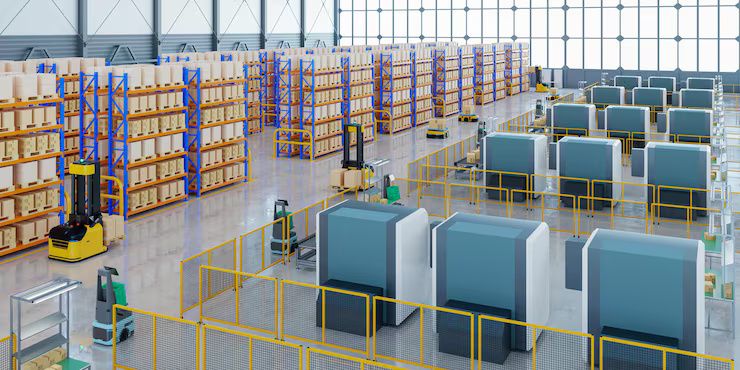Discover Smarter Ways to Manage Storage with Modern Warehousing
Warehousing refers to the process of storing goods, materials, and products in a dedicated space until they are needed for manufacturing, distribution, or sale. It exists because businesses require organized, secure, and efficient storage solutions that help them manage inventory while ensuring steady product availability.
Modern warehousing has evolved significantly from traditional storage methods. Earlier, warehouses focused mainly on keeping goods safe and protected from environmental damage. Today, warehousing involves advanced technologies, optimized layouts, real-time monitoring, and automated systems. These improvements help organizations maintain accurate inventory levels, reduce storage costs, improve logistics, and respond faster to customer demands.

As supply chains grow more complex, the role of warehousing has expanded into areas like order processing, packaging, sorting, and data-driven forecasting. This shift makes storage management a vital part of daily business operations across multiple industries such as retail, manufacturing, pharmaceuticals, agriculture, and e-commerce.
Importance
Modern warehousing is important because it helps organizations deal with challenges in demand forecasting, product availability, and inventory efficiency. As customer expectations for fast delivery increase, businesses need reliable storage processes that ensure accurate stock levels and rapid dispatch.
Key reasons why this topic matters today
-
Growth of e-commerce: Online shopping has increased the volume of stored goods, requiring quicker fulfillment and efficient inventory workflows.
-
Higher customer expectations: Same-day and next-day delivery services depend on precise storage and rapid order picking.
-
Global supply chain unpredictability: Transport delays, raw material shortages, and demand surges make well-structured warehousing essential.
-
Cost control: Businesses use modern warehousing to reduce labor costs, minimize inventory errors, and avoid overstocking or stockouts.
-
Safety and compliance: Proper storage methods help avoid product damage, contamination, and safety risks for workers.
Who it affects
-
Manufacturers
-
Retailers and wholesalers
-
E-commerce companies
-
Logistics and transport providers
-
Exporters and importers
-
Small businesses managing physical inventory
Problems it helps solve
-
Inventory discrepancies
-
Damaged or misplaced goods
-
Slow order fulfillment
-
Inefficient use of warehouse space
-
High labour expenses
-
Low visibility into stock movement
-
Delays in delivery
Recent Updates
Modern warehousing has seen major advancements in the past year as companies continue adapting to new technologies and changing market conditions. Several developments have shaped the direction of smart storage and logistics:
1. Rise of AI-driven inventory systems (2024–2025)
AI forecasting tools have become increasingly common, helping businesses predict demand patterns, seasonal trends, and reorder points. Many companies started integrating AI-based warehouse management systems (WMS) to improve accuracy and reduce manual errors.
2. Growth of robotic automation
By mid-2024, more warehouses adopted automated guided vehicles (AGVs), robotic arms, and autonomous mobile robots to assist in picking, sorting, and transferring goods. These systems help reduce worker fatigue and enhance efficiency.
3. Expansion of micro-warehousing
Urban micro-warehouses gained traction in 2024 as businesses aimed for shorter delivery times in densely populated cities. These smaller facilities reduce last-mile delivery costs.
4. Increased focus on sustainability
In 2024–2025, there was a rise in eco-friendly warehousing practices such as solar-powered lighting, recyclable packaging stations, and energy-efficient HVAC systems.
5. Growth in real-time tracking through IoT
Companies adopted IoT-enabled sensors to monitor temperature, humidity, location, and movement of goods. Industries such as pharmaceuticals and food storage especially benefited from this.
6. Data-led safety monitoring
Warehouses increasingly used digital systems to track worker health, machine performance, and hazard zones, helping reduce accidents and downtime.
Laws or Policies
Warehousing operations are influenced by safety, environmental, taxation, and compliance regulations. Although policies vary by country, most governments emphasize safe storage practices and proper handling of goods.
Common rules affecting warehousing
-
Occupational safety guidelines: Regulations often require proper training, protective equipment, and safety signage in storage facilities.
-
Fire safety rules: Warehouses must follow guidelines for fire extinguishers, alarms, sprinkler systems, and safe storage of flammable materials.
-
Environmental standards: Limits may be placed on emissions, waste handling, and energy usage.
-
Food and pharmaceutical storage regulations: Industries dealing with temperature-sensitive goods must follow guidelines on refrigeration, packaging, and hygiene.
-
Import/export laws: Warehouses handling bonded goods must comply with customs regulations.
Additional storage-specific requirements
| Regulation Area | Meaning | Examples of Requirements |
|---|---|---|
| Safety Compliance | Ensures worker protection | Proper equipment, clear pathways |
| Environmental Controls | Reduces energy and waste | Efficient lighting, waste audits |
| Product Handling | Protects stored goods | Temperature & humidity monitoring |
| Documentation | Supports transparency | Accurate records & labeling |
These regulations help ensure that goods remain safe, workers are protected, and businesses remain compliant with national standards.
Tools and Resources
A variety of tools and platforms help improve modern warehousing operations. These resources assist in inventory monitoring, space management, order tracking, and workflow organization.
Helpful Tools and Systems
-
Warehouse Management Systems (WMS)
-
Zoho Inventory
-
NetSuite WMS
-
TallyPrime Inventory
-
Fishbowl Inventory
-
-
Inventory Tracking Tools
-
RFID scanners
-
Barcode labeling systems
-
IoT-based tracking sensors
-
-
Automation and Robotics Solutions
-
Automated Storage and Retrieval Systems (AS/RS)
-
Pick-to-light and put-to-light systems
-
AGVs and AMRs
-
-
Planning and Optimization Tools
-
Slotting software
-
Demand forecasting calculators
-
Real-time dashboard tools
-
-
Safety and Compliance Tools
-
Digital checklists
-
Worker safety monitoring apps
-
Temperature and humidity tracking systems
-
Useful Templates and Online Resources
-
Warehouse layout planning templates
-
Inventory cycle count sheets
-
Pallet tracking spreadsheets
-
Online barcode generators
-
Logistics and supply chain knowledge portals
These tools help businesses create more organized, efficient, and cost-effective storage environments.
FAQs
1. What is the main purpose of modern warehousing?
The main purpose is to store goods safely and efficiently while supporting inventory control, order fulfillment, and smooth supply chain operations.
2. How does automation help in warehousing?
Automation enhances speed, reduces errors, and minimizes manual labor. Tools like conveyor systems, robotic pickers, and automated storage systems help improve overall productivity.
3. Are warehouse management systems necessary for small businesses?
Not always, but they can be helpful. A small business may use spreadsheets or simple inventory apps, while growing businesses often benefit from a full WMS for better accuracy and tracking.
4. What factors should be considered when designing a warehouse layout?
Important factors include available space, type of goods stored, expected movement of products, safety requirements, loading/unloading areas, and equipment placement.
5. What are the common challenges in storage management?
Challenges include stock discrepancies, slow picking times, limited space, safety hazards, and irregular demand. Modern systems help reduce these issues.
Final Thoughts
Modern warehousing plays an essential role in supporting business operations across industries. With advancements in automation, real-time tracking, and AI-driven forecasting, storage management has become smarter, more efficient, and more adaptable to changing needs. As companies continue to expand and serve customers with faster delivery expectations, effective warehousing strategies remain crucial. Whether a business operates a small storage facility or a large distribution center, modern tools and structured processes help ensure accuracy, safety, and long-term sustainability in the supply chain.





